Downwards movement has invalidated the main hourly Elliott wave count, but is not yet enough to confirm the alternate wave count. What happens tomorrow is crucial.
Summary: Price is right at the lower blue 2-4 trend line on the main daily wave count. For the main wave count upwards movement must resume tomorrow. If that trend line is breached I must discard the main wave count. The alternate wave count now requires a new low below 2,039.69.
Click charts to enlarge.
Bullish Wave Count
Upwards movement from the low at 666.79 subdivides as an incomplete 5-3-5. For the bull wave count this is seen as primary waves 1-2-3.
The aqua blue trend lines are traditional technical analysis trend lines. These lines are long held (the lower one has its first anchor in November, 2011), repeatedly tested, and shallow enough to be highly technically significant. When the lower of these double trend lines is breached by a close of 3% or more of market value that should indicate a substantial trend change. It does not indicate what degree the trend change should be though. It looks like the last five corrections may have ended about the lower aqua blue trend line, which gives the wave count a typical look. To see a weekly chart where I have drawn these trend lines click here.
Today, downwards movement is finding support at the upper of the double aqua blue trend lines. This is very likely to be the low for minuette wave (iv), and the final fifth wave should begin tomorrow from here.
The wave count sees intermediate wave (5) as an ending contracting diagonal. Ending diagonals require all sub waves to be zigzags. So far this is a perfect fit. Minor wave 3 has stronger momentum than minor wave 5 on the daily chart.
The diagonal is contracting. The only problem with this possibility is that minor waves 2 and 4 are more shallow than second and fourth waves within diagonals normally are. In this case they may have been forced to be more shallow by support offered from the double aqua blue trend line.
Because the third wave within the contracting diagonal is shorter than the first wave and a third wave may never be the shortest wave, this limits the final fifth wave to no longer than equality with the third wave at 2,253.79.
Within intermediate wave (5) minor wave 1 lasted 238 days (5 days longer than a Fibonacci 233), minor wave 2 lasted 18 days (2 short of a Fibonacci 21), minor wave 3 lasted 51 days (4 short of a Fibonacci 55) and minor wave 4 lasted 23 days (2 longer than a Fibonacci 21). While none of these durations are perfect Fibonacci numbers, they are all reasonably close. So far minor wave 5 has lasted 35 days and the structure looks incomplete. Minor wave 5 may not exhibit a Fibonacci duration. Within it minute wave c will total a Fibonacci 13 if it ends in four more sessions.
Within minor wave 5 minute wave b may not move beyond the start of minute wave a below 1,980.90.
Contracting diagonals normally have fifth waves which end with a slight overshoot of the 1-3 trend line. Because this is such a common tendency I will still expect more upwards movement to see this trend line overshot. It is possible that the fifth wave is over already, and this idea is presented as an alternate.
Diagonals almost always adhere well to their trend lines. This one has slight overshoots within minute wave a of minor wave 3, but the 1-3 trend line is not breached. For this diagonal to have the “right look” minute wave c must continue upwards from here. A breach of the lower blue 2-4 trend line would see this wave count substantially reduced in probability in favour of the alternate below.
At 2,178 minute wave c would reach equality in length with minute wave a.
If this wave count is correct then downwards movement cannot be a fourth wave correction and must be a deep second wave correction. Minuette wave (i) is seen here as a five wave impulse, but this does not have as neat a fit as the alternate hourly wave count.
Minuette wave (ii) must end here and may not breach the blue 2-4 trend line on the daily chart.
This main wave count expects a third wave up to begin tomorrow.
Minuette wave (ii) may not move beyond the start of minuette wave (i) below 2,039.69.
Alternate Bullish Wave Count
This wave count is identical to the main wave count up to the low labelled minor wave 4. Thereafter, this alternate looks at the possibility that minor wave 5 may be over. Minor wave 5 would have fallen slightly short of the 1-3 trend line. This is unusual but does occasionally happen for fifth waves of contracting diagonals.
A new low below 1,980.90 would invalidate the main wave count. A close below the lower aqua blue trend line of 3% or more of market value would provide added confidence in this wave count. At that stage I would expect that downwards movement may be the early stages of primary wave 4. The bearish wave count below would also be entirely possible, but would require further confirmation.
Primary wave 2 was a 0.41 zigzag correction lasting 62 days in total. I would expect primary wave 4 to be more shallow because it may find support at the lower edge of an Elliott channel (which must be drawn on a weekly chart at this stage). Primary wave 4 should break out of the black channel copied over here from the weekly chart (this is a channel containing primary wave 3). A breach of that channel would provide further confidence that primary wave 3 is over and primary wave 4 is underway.
Primary wave 4 may last about a Fibonacci 55 days if it is a flat correction. If it is a combination or triangle it may be more time consuming, maybe up to a Fibonacci 89 days.
We should always assume the trend remains the same, until proven otherwise. At this early stage we have no confirmation of a big trend change, so this idea must remain an alternate until we do. We should assume the trend remains up.
The new downwards movement has an ambiguous first wave down, which may be seen as either a three or a five. It would most likely be a five because the first wave down is more likely to be an impulse than a leading diagonal.
This wave count expects a third wave down to continue tomorrow. At 1,986 minute wave iii would reach 1.618 the length of minute wave i.
Minute wave iii must move below the end of minute wave i at 2,039.69. A new low below this point would add substantial confidence to this alternate wave count at this stage.
Within minute wave iii minuette wave (i) would be incomplete. Minuette wave (ii) which should follow may not move beyond the start of minuette wave (i) above 2,114.86.
Bear Wave Count
The subdivisions within primary waves A-B-C are seen in absolutely exactly the same way as primary waves 1-2-3 for the bull wave count. The alternate bull wave count idea also works perfectly for this bear wave count.
To see the difference at the monthly chart level between the bull and bear ideas look at the last historical analysis here.
At cycle degree wave b is over the maximum common length of 138% the length of cycle wave a, at 167% the length of cycle wave a. At 2,393 cycle wave b would be twice the length of cycle wave a and at that point this bear wave count should be discarded.
While we have no confirmation of this wave count we should assume the trend remains the same, upwards. This wave count requires confirmation before I have confidence in it.
This analysis is published about 08:13 p.m. EST.

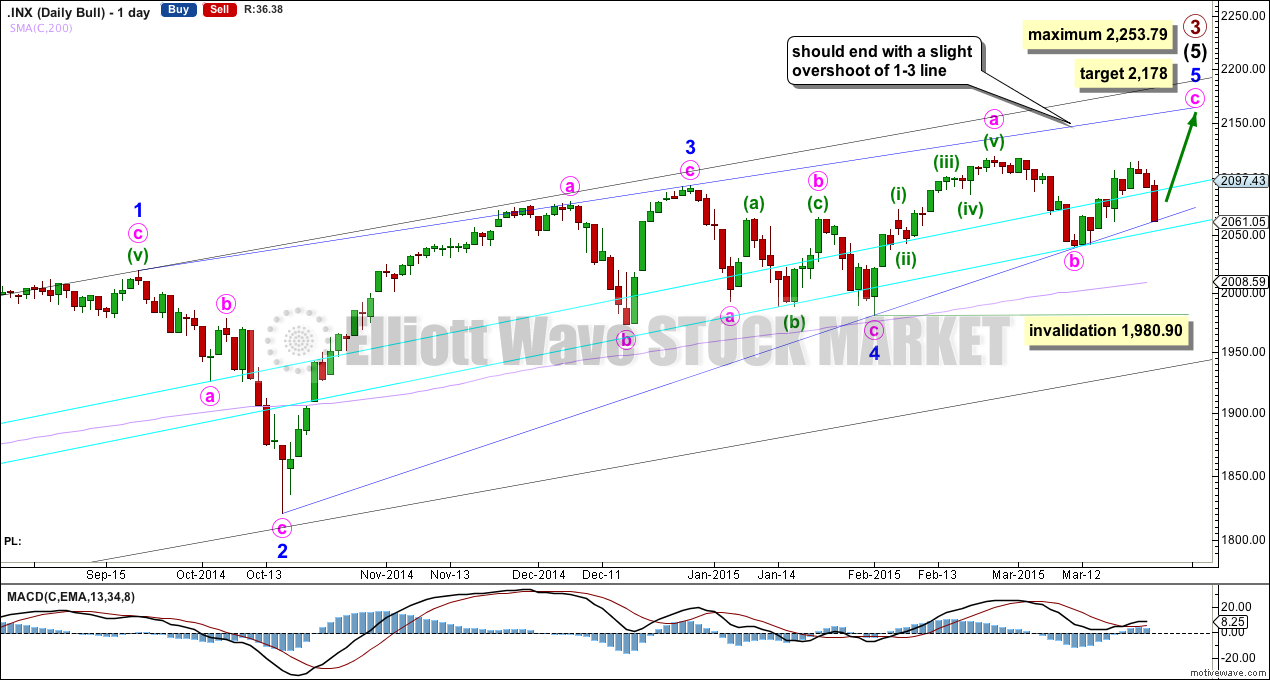
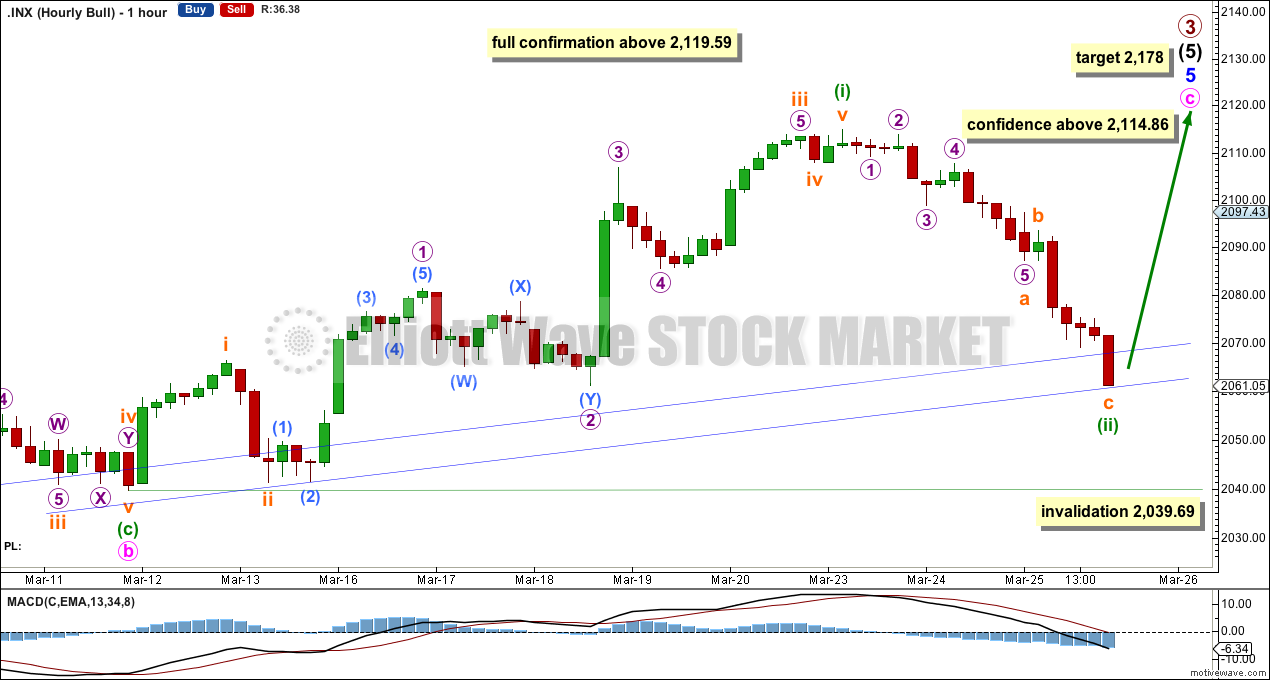
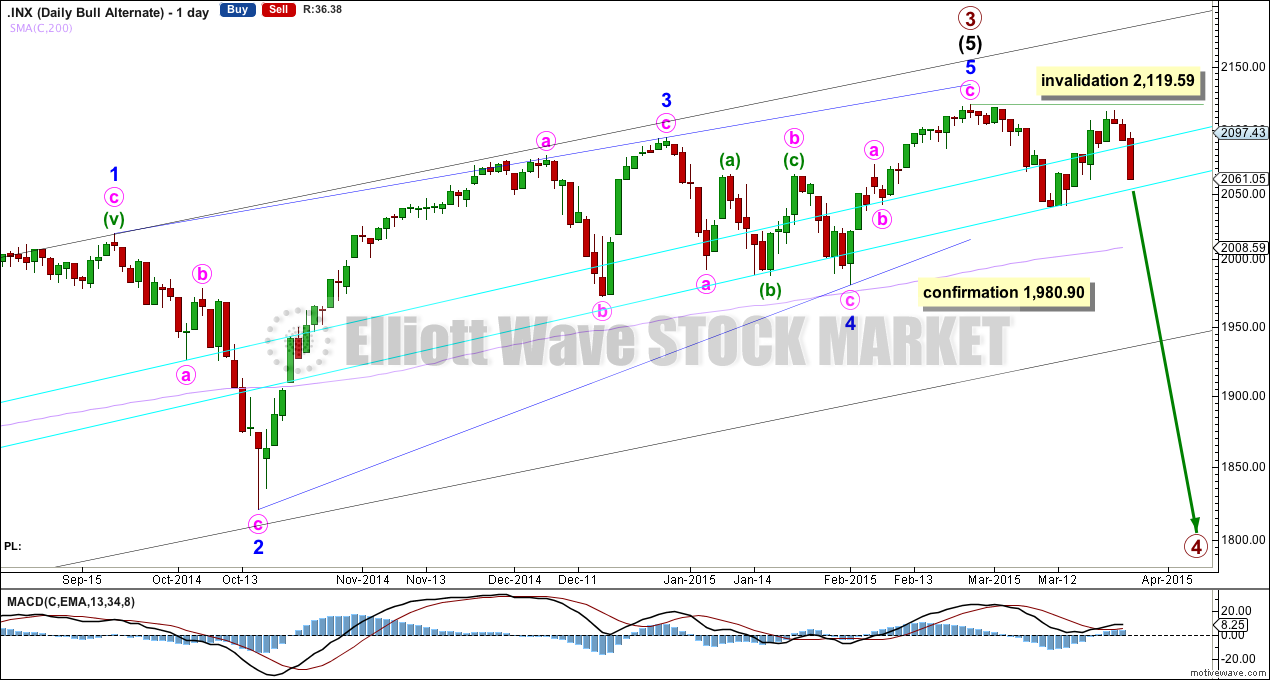
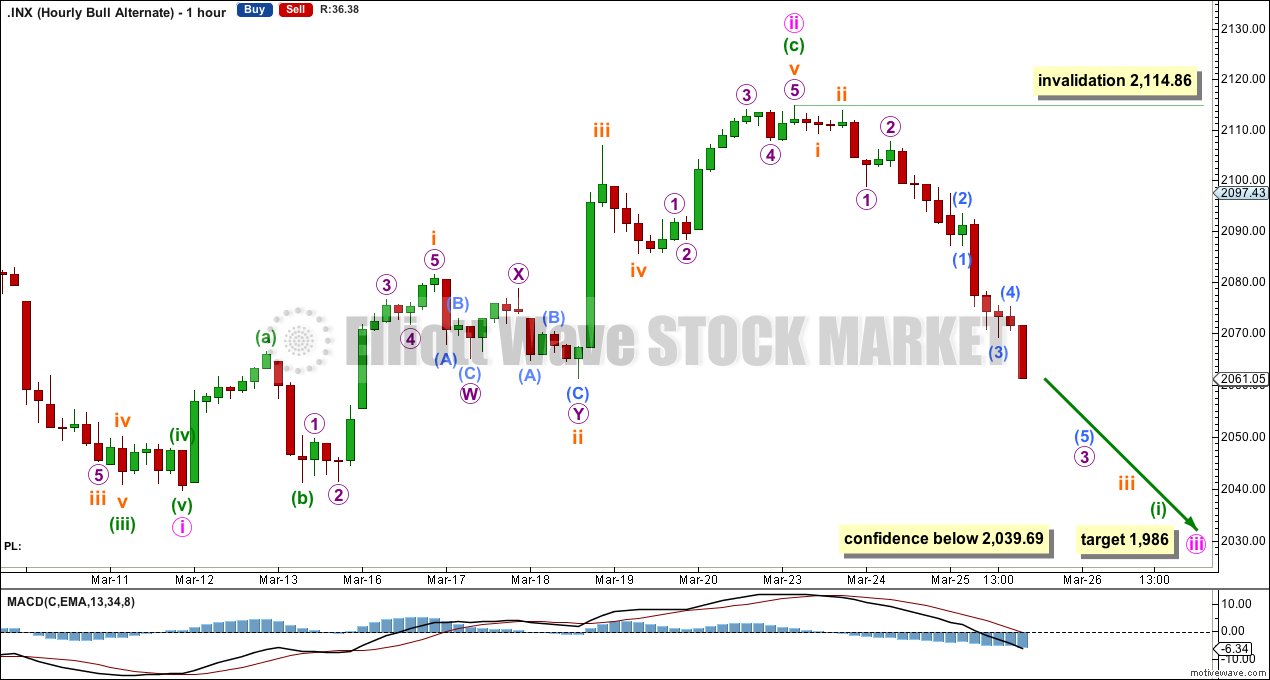
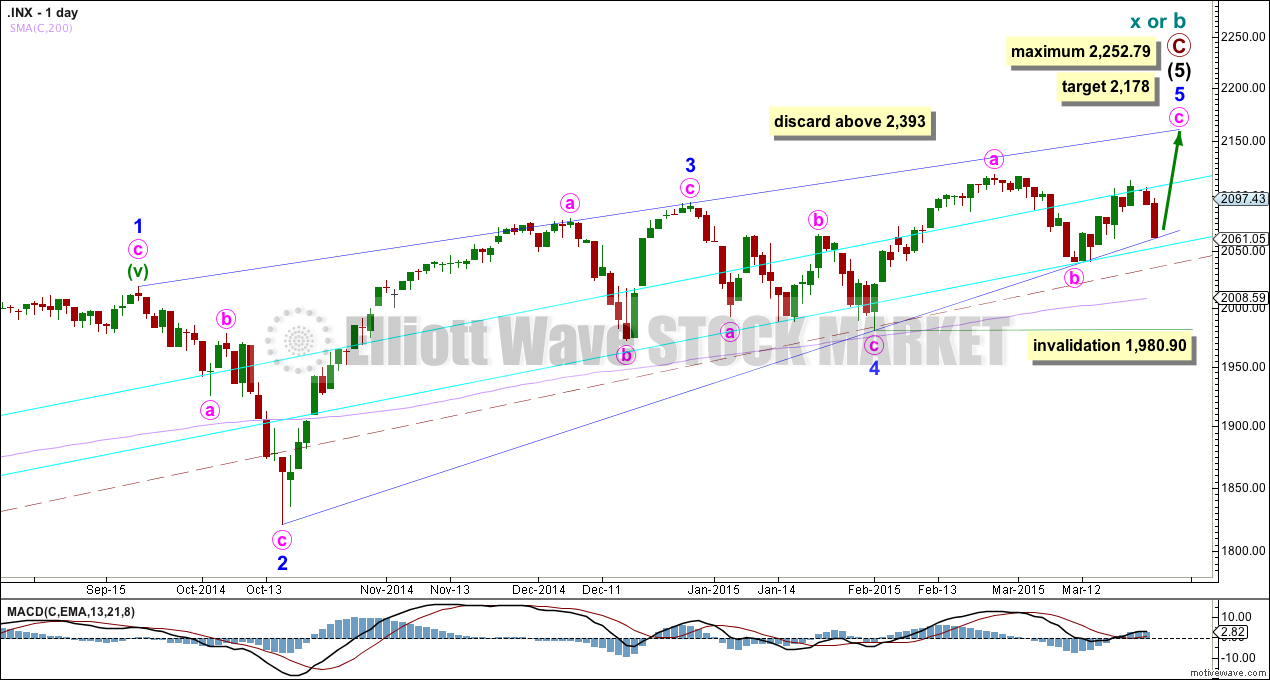
Doug I’m so sorry for the delay in moderating your comment.
You’re whitelisted now so that won’t happen again.
Primary wave 3 may only subdivide as an impulse. The high labelled minor wave 1 completes a movement which may only be seen as a zigzag.
I’m playing with the idea primary wave 3 may have ended at the high labelled minute wave a within minor wave 3, there it could be a complete impulse. But then that leaves primary wave 4 a mess, and I’m struggling to see a wave count which avoids truncations within primary wave 4.
Hi Lara. With today’s drop to a low of 2045.50, I think the possibilities depend on how far the drop will continue further tomorrow, if it does.
If the drop slows down, then the main count minor 5 minute b is still ongoing at 2119.59 – 2039.69 – 2114.86 – slightly lower than 2045.50 for a flat.
If the drop becomes more pronounced, say up to a retrace of 1.618, then the main count would be nearing invalidation (at 1980.90) and the alternate count has a higher probability. Intermediate A will be 2119.59 – 2039.69 – 2114.86 – (1985.58) – two more waves for a 5-wave impulse. The third wave could retrace further than 1.618 since the drop so far goes down to 2045.50. I just used 1.618 as illustration only.
Does this make sense? Still trying to hone my skills as a wave-counter.
What if primary 3 ended where you have minor 1 ending and primary 4 ending where you have minor 2 ending… Therefore today was the completion of wave b of 5 of the ending diagonal. Would that fit better?